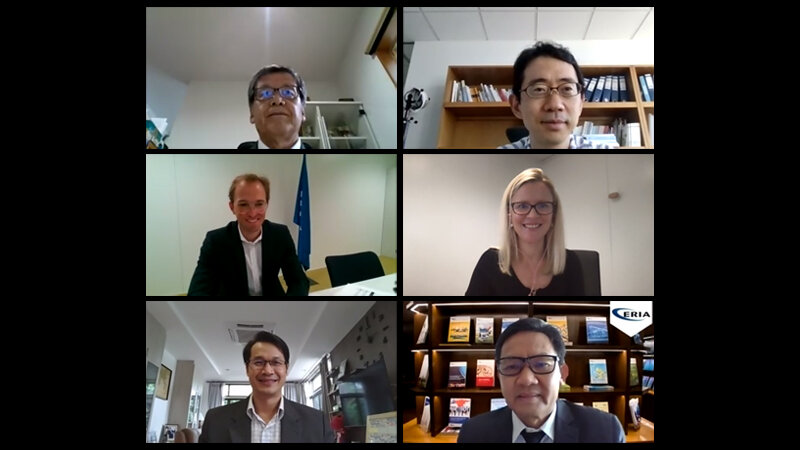ASEAN’s Energy Challenges: a Boon for Future CCUS Development
Jakarta/Paris, 26 July 2021: The future of carbon capture, utilisation, and storage (CCUS) technologies in Southeast Asia looks promising, based on a conference held by the Asia CCUS Network in partnership with the International Energy Agency (IEA). The discussion regarding this carbon-neutral technology was part of the ground-breaking 1st Asia CCUS Network Knowledge Sharing Conference held on 26 July 2021. The Association of Southeast Asian Nations (ASEAN) and the East Asia Summit region initiated the Asia CCUS Network as a response to the significant challenges regarding the region’s future energy landscape on a low carbon energy transition as well as net-zero emissions; the network is managed by the Economic Research Institute for ASEAN and East Asia (ERIA) as its secretariat.
In his Opening Remarks, Director-General for Research and Policy Design Administration at ERIA, Mr Taizo Hara stated that the knowledge sharing conference is crucial to bridge the knowledge gap in terms of policy, investment, opportunities, and CCUS technology development between a CCUS developing group and a CCUS developed group. Mr Hara also asserted the Network’s aim to contribute to the decarbonisation in Asia through CCUS development.
Senior Energy Economist at ERIA, Dr Han Phoumin introduced Ms Samantha McCulloch, Head of CCUS Unit at IEA, who shared key findings from the latest IEA published report on 'CCUS: The Opportunity in Southeast Asia' about the trajectory of energy demand and carbon dioxide (CO2) emissions in the region. Among the IEA’s findings is the critical role of CCUS technologies in reaching net-zero targets. Globally, $12 billion have been committed to CCUS projects and programmes since 2020 and Southeast Asia is partaking in this momentum. As such, it underscores the gravity of the Asia CCUS Network’s role in realising the global aim of net-zero emissions by 2050.
Dr Raimund Malischek, Energy Analyst at IEA, elaborated the role of CCUS technologies in reducing emissions and its prospect in Southeast Asia. With 4 gigatonnes of CO2 needed to be captured globally by 2035 and 7.6 gigatonnes by 2050, CCUS can massively contribute to emissions reduction in the world’s energy system. It is of particular importance for Southeast Asia’s industries and policymakers to support CCUS deployment and development given that the region remains heavily reliant on fossil fuels. IEA data suggest that 90% of the region’s growth since 2000 has been fuelled by coal, natural gas, and oil, and that the use of fossil fuels between 2000 – 2019 more than doubled. The region’s annual CO2 emissions increase at a rate of 4% in which ASEAN’s emissions account for around 5% of total global emissions.
To commit to its net-zero emissions path, the role of CCUS in Southeast Asia must span all parts of the energy systems particularly because over 200 million tonnes of CO2 emissions must be captured by 2050. There is thus enormous capture and CCUS potential in the region requiring $1 billion in annual investments for CO2 capture facilities by 2030. One means that ASEAN can take is to retrofit its existing energy infrastructure with capture facility, for instance from power generation and industry sector, which is considerably young. It can also establish CO2 storage as part of the CCUS supply chain with Indonesia taking a leading role in CCUS deployment in the region. The IEA found that there were numerous old gas and deep-sea oil holes in the vicinity of the Java Island in Indonesia and in Kalimantan and Sumatra which can be utilised for CO2 storage. Malaysia, Indonesia, and northern Australia can also engage in future offshore gas development to form the bases of new CCUS hubs. To act on these windows of opportunities, ASEAN will require tremendous international support, capacity building, private sector investment, and the availability of debt financing mechanisms.
Dr Twarath Sutabutr, Chief Inspector General, Ministry of Energy, Thailand, commented on several ASEAN-specific concerns: the readiness of Southeast Asia’s financial institutions to finance high-capital projects and confidence in the availability of safe and secure CO2 storage.
Ms McCulloch shared how ASEAN can explore having a shared infrastructure for CO2 storage resources, as had been done by Norway, for the commercialisation of CO2 storage and transportation in the CCUS supply chain. She emphasised that when it comes to policy support, what works in one country may not work in another thus options to establish a CCUS supply chain must be tailored to regional circumstances and preferences.
The online conference ended on a positive note and the agreement that CCUS will have a crucial role in a carbon-neutral world. In his Closing Remarks, Mr Shigeru Kimura, Special Advisor to the President on Energy Affairs at ERIA, underlined how the application of CCUS in ASEAN’s power sector can have an enormous effect in reducing carbon emissions. Therefore, working towards the recommendations by the IEA and seeking international collaboration is important in realising regional climate and energy targets. The demand and trajectory of Southeast Asia’s energy sector currently put it at odds with current climate and energy goals, but it is exactly these challenges that encourage innovative solutions like CCUS to decarbonise the region.

